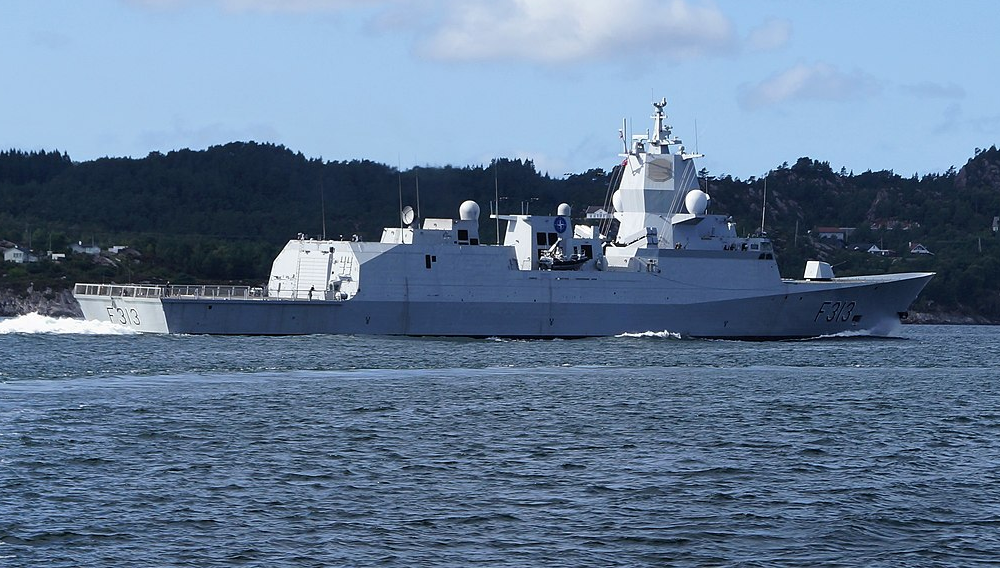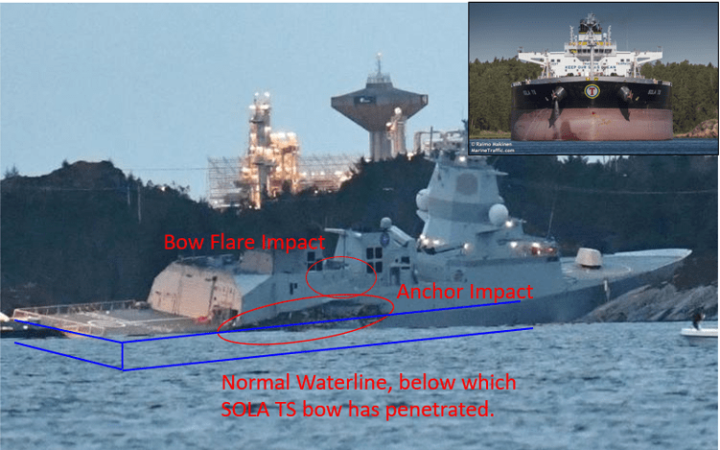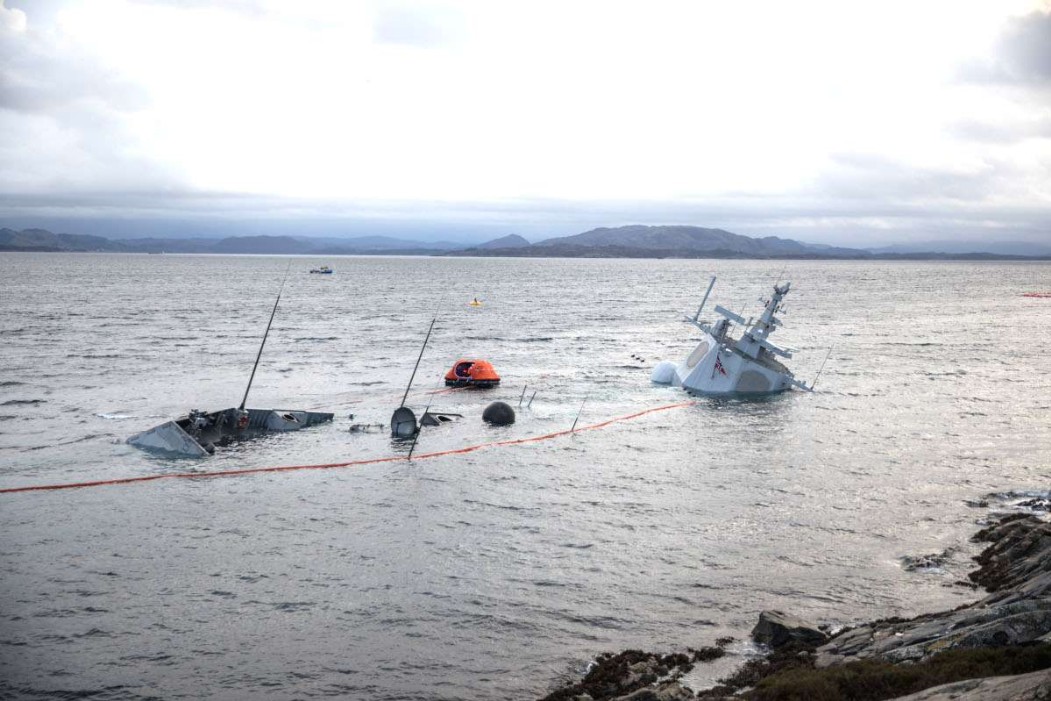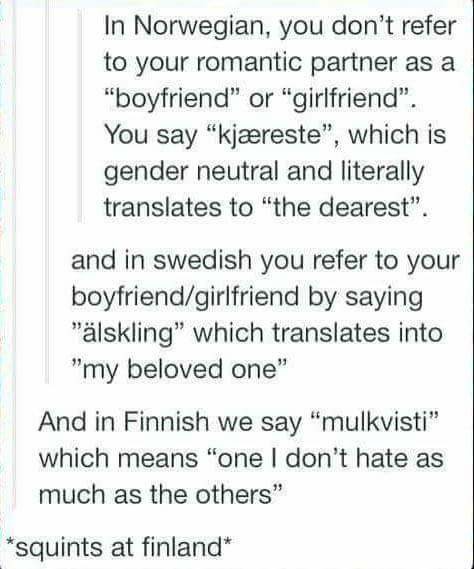Extra Credits
Published on 8 Dec 2018Writer Rob Rath talks about all the cool stories and facts we didn’t get to cover in the already expansive Viking Expansion series.
Join us on Patreon! http://bit.ly/EHPatreon
7:08 – Rob learns he has a linguistic tic about being able to correctly distinguish “ancestor” and “descendant”
17:10 – Olga of Kiev scared Matt to death… really though…
25:23 – Walpole Connection
28:05 – what’s next on Extra HistorySome other works to check out: The Sea Wolves: A History of the Vikings, by Lars Brownworth / The Vikings, by Else Roesdahl / Podcast: Norse by Northwest
December 11, 2018
Viking Expansion – Lies – Extra History
December 2, 2018
Preliminary report posted on the sinking of Norwegian frigate Helge Ingstad
The Accident Investigation Board of Norway (AIBN) and the Defense Accident Investigation Board of Norway (DAIBN) have made their initial joint report on the sinking of HNoMS Helge Ingstad available to the public:
“This report is a preliminary presentation of the AIBN’s investigations relating to the accident and does not provide a full picture,” the report warns up front. “The report may contain errors and inaccuracies.”
Based on what the investigators have determined so far, Helge Ingstad entered the fjord heading south and checked in with the Fedje Maritime Traffic Center, or Fedje VTS, at around 2:40 AM local time. Any ship over 80 feet long has to alert this control center before entering due to the narrow nature of the waterway.
The ship was traveling at approximately 20 miles per hour and had its navigation lights on. The ship’s Automatic Identification System (AIS) transponder was set to “receive only” mode, meaning that it was not transmitting its own position and other information to ships in the area.
At 3:40 AM, personnel on Helge Ingstad‘s bridge began to turn control of the ship over the next watch. At that time, the ship’s crew was aware of three northbound ships on its radar screen and had also visually observed “an object with many lights was observed lying still just outside the Sture terminal,” according to the report.
Sola did not leave the terminal until 3:45 AM. Less than 15 minutes later, the tanker’s crew radioed the Fedje VTS to inquire about a contract on their radar that was sailing with its AIS transponder apparently off.
At 4:00 AM, Fedje VTS identified the ship in question as probably Helge Ingstad and the tanker and the frigate began communicating directly. Approximately one minute later, the two ships collided.
[…]
A final report on the incident should contain more thorough explanations of exactly how the final moments of the collision played out and recommendations for the Norwegian Navy to try and prevent these sorts of accidents in the future. “So far, the AIBN has not seen any indication of technical systems not working as intended up until the time of the collision,” the report notes.
Separate from its findings regarding the events leading to the collision, the AIBN has also uncovered a serious technical issue that could have impacts well beyond this particular accident. Norwegian officials have alerted both the country’s navy and Spanish shipbuilder Navantia, which built the Helge Ingstad and Norway’s four other Fridtjof Nansen-class frigates, with concerns they have about the basic “watertight integrity” of the ships.
“The AIBN has found safety critical issues relating to the vessel’s watertight compartments,” an annex to the main report explains. “This must be assumed to also apply to the other four Nansen-class frigates. It cannot be excluded that the same applies to vessels of a similar design delivered by Navantia, or that the design concept continues to be used for similar vessel models.”
Update, 24 June 2019: The Norwegian government has decided to scrap the ship rather than undertake repairs.
To no one's surprise, #Norway has officially decided to scrap the #frigate #HELGEINGSTAD F313 rather than repair her. Repairs would cost a bit more than building a new ship. The govt wants to replace the lost capability but has yet to decide how. https://t.co/eslMmkQ6Jj pic.twitter.com/o0YB2R4zrY
— Chris Cavas (@CavasShips) June 23, 2019
November 19, 2018
What we know about the sinking of the HNoMS Helge Ingstad near Bergen
The Verdigris blog has a very interesting analysis of what seems to have happened leading up to the collision of the Norwegian frigate HNoMS Helge Ingstad and the tanker Sola TS in the restricted waters near Bergen:

HNoMS Helge Ingstad, a Fridtjof Nansen-class frigate commissioned in 2009.
Photo detail via Wikimedia Commons
The island west of the collision location is Alvoyna in the Oygarden municipality, and the oil terminal at Sture is a busy port that receives large tankers such as the Sola TS which was involved in the collision. Otherwise the islands in this area are relatively sparsely populated with just 4,900 or so inhabitants across the whole municipality. From that we can assume that there would be few lights at night to mark the shoreline, with the exception of the oil terminal which would be brightly lit. The channel is approximately 2 miles wide but is relatively deep, narrowing south of Sture into a channel little over a mile wide.
The collision occurred at approximately 0400 local time on Thursday 8th November 2018. Sunset the previous evening was at approximately 1623; sunrise would not be until 0821. There was no moon; the moon set at around 1718 the previous day and would not rise until 0847. We cannot be certain of the weather conditions which may have restricted visibility. However, there is no evidence of weather or high seas on the radar picture and if visibility was restricted by rain or fog, a ship would be unlikely to be sailing at high speed.
Finally the ships involved. Sola TS is a Maltese flagged oil tanker of 62,000 tonnes. We know she had 23 personnel onboard and after the collision was reported to have little or no damage. Merchant ships are usually well built, especially when carrying petroleum cargoes which if leaked could have devastating environmental consequences; consequently the lack of damage is hardly a surprise. As a result they are sluggish, slow to manoeuvre or accelerate/decelerate. They are not, however, considered to be ‘restricted in their ability to manoeuvre’, a special condition identified in the International Regulations for the Prevention of Collision at Sea – the IRPCS or ‘Rules of the Road’ – this is a condition applied only to vessels which are restricted by their work, such as picking up or laying submarine cables or pipelines, launching or recovering aircraft, carrying out underway replenishment, etc. Sola TS might have been slow to manoeuvre, but she is not exceptional and is unlikely to have carried any special status. Sola TS had a tug, Tenax, in company and might conceivably have been considered to be under tow; however, once again no special status is conferred unless the nature of the tow made it particularly difficult to alter course. The tug is more than likely to have been pacing the tanker, probably not connected and likely a precaution for a fully laden oil tanker in narrow waters.
Helge Ingstad, by contrast, is a Fridtjof Nansen-class air defence frigate of just 5,290 tonnes. Lightly built for speed and manoeuvrability, warships are invariably less robust than merchant ships, but are more tightly compartmented and have more complex damage control arrangements to compensate.
Very quickly after the collision, the Helge Ingstad was run ashore to prevent the ship sinking, but the ship slid down further into the water, despite attempts to keep her close in shore, and eventually slipped down almost completely beneath the waterline:
The consensus among the commenters is that the ship can probably be re-floated, but that the damage to the electronic gear onboard most likely renders her a complete loss:
Regardless of the circumstances, the loss of Helge Ingstad, even temporarily, is a major blow to the Royal Norwegian Navy, which relies on the Fridtjof Nansen-class as its primary surface combatants, especially in a time of increased tensions between Norway and its NATO allies and Russia. The frigate had been on its way back from a massive NATO-led exercise, called Trident Juncture, the largest such drill in decades, when the accident occurred.
If it turns out that Helge Ingstad is a total loss, which seems likely at this point, it could have a significant impact on Norwegian naval operations for years to come. In the meantime, we will continue to follow this story closely and provide any additional updates as they become available.
November 12, 2018
Viking Expansion – Ireland – Extra History – #3
Extra Credits
Published on 10 Nov 2018When Thorgest arrived on the coasts of Ireland with over a hundred long ships, he was ready to raid — and to establish cities like Dublin and many others that shaped the religion and culture of Ireland, much to the population’s excitement.
Join us on Patreon! http://bit.ly/EHPatreon
October 30, 2018
Viking Expansion – The Serpent-Riders – Extra History – #1
Extra Credits
Published on 27 Oct 2018The medieval Scandinavians left an impact not just on Greenland and Iceland, but on France, England, Russia, and even briefly North America. But how did Scandinavian society begin, and what incited its voyage across the seas?
Join us on Patreon! http://bit.ly/EHPatreon
June 13, 2018
Scandinavian love
April 7, 2018
The Danelaw – Alfred vs. Guthrum – Extra History – #1
Extra Credits
Published on 5 Apr 2018The Vikings moved from Scandinavia to the coasts of Britain, intent on establishing a new kingdom by any blood necessary. What they probably didn’t expect was that one of their own leaders, Guthrum, and the local king, Alfred, would end up cooperating on the creation of a kingdom for the Danes.
Sponsored by Total War Saga: Thrones of Britannia! http://store.steampowered.com/app/712100/Total_War_Saga_Thrones_of_Britannia/
April 3, 2018
The Neutral Ally – Norway in WW1 I THE GREAT WAR Special
The Great War
Published on 2 Apr 2018Norway declared neutrality when the First World War broke out and as a nation with a large merchant fleet, profited from the war economically.
September 25, 2017
Great Northern War – V: Rise and Fall – Extra History
Extra Credits
Published on 23 Sep 2017Charles XII narrowly escaped the Russian pursuit, with help from the Ottoman Empire. But the weak points in his army had been clearly exposed. Northern Europe united against him – but of course, Charles XII responded by launching a fateful counter-offensive into Norway.
August 23, 2017
On the most recent figures, people do want to pay more tax … just not many of ’em, and not very much
Last month, I posted an item on the Norwegian experiment in encouraging taxpayers to pay more than they owed in national tax. More recently, Tim Worstall reports an uptick in UK taxpayers voluntarily sending Her Majesty’s government more than they owed:
… the greater publicity of this ability to pay more has indeed led to more people making those extra voluntary payments. Further, to a more regular reporting of how many do so:
Jeremy Corbyn’s claim that many people want to pay “more tax” to clear the national debt or fund public services has been undermined by official figures.
Figures disclosed by the Government show that just 15 taxpayers made financial gifts worth less than £200,000 to the Government over the past two years.
15 people is of course more than 5.
The Debt Management Office said that £180,393 in 2016/17 and £14,558 in 2015/16 was made in these voluntary payments.
Most of this came from a single bequest of £177,700 in the last financial year. The other donated or bequeathed by the other 14 people were for relatively trivial sums. Someone gave 1p, another gave 3p and a third person handed over £1.84 to the Government.
Although not that much more then if we’re honest about it.
[…]
At which point something economists are most insistent upon. What people say is nowhere near as good a guide to their beliefs as what people do is. Expressed preferences are all very well but the truth comes from revealed preferences. Many might say they will pay higher taxes in order to gain more government. Very few do, so few that we can dismiss the expressed wish as being untrue.
It could of course be true that many would like other people to pay more in taxes, it could even be true that some to many would happily pay more if others did as well. But those are different things, the argument that people wish to pay higher taxes themselves and themselves alone has been tested and been found to be wrong–simply because when the opportunity is made available people don’t.
Once again, for my Canadian readers, it’s totally legal and acceptable to pay Her Majesty in right of Canada any additional monies you might feel are appropriate…
July 11, 2017
Norway’s experiment with inviting people to pay more tax than they owed
Tim Worstall reports on the results of a Norwegian initiative to encourage taxpayers who felt their taxes should be higher to voluntarily pay more:
It is a standard contention of our times that people really would love to pay more tax. The things they get in return from government are so wondrous that obviously everyone will be emptying their wallets to feed the diversity advisers. Norway tried this — they managed to raise an extra $1,325 in tax revenues.
That’s not bad, $1,325 per capita in additional tax revenues multiplied by the Norwegian taxpaying population is … oh, you mean that was the total amount?
This does not bode well for the general contention, does it?
What we have here is of course that classic economists’ point, the difference between expressed preferences and revealed ones. We’ll all say all sorts of things but the correct guide to what we really want is to watch what we do. Which isn’t, even in Norway in any large manner, pay more tax:
Hammered by the opposition for slashing taxes and going on a spending spree with the country’s oil money, the center-right government has hit back with a bold proposal: voluntary contributions.
Launched in June, the initiative has received a lukewarm reception, with the equivalent of just $1,325 in extra revenue being collected so far, according to the Finance Ministry.
It is possible to cavil about this a bit. It’s all rather new for example.
The program was decried as a political distraction from the left-of-center opposition party, who said that if the government was really serious about making up for recent revenue shortfalls then it would go after multinational companies like Google and Facebook. Launched only this past June, the opposition has argued that the scheme already costs more than it makes.
Well, yes, they would say that too. Quite clearly everyone prefers it to be that person over there getting taxed, not little ol’ me.
You don’t have to be Norwegian to take advantage of this wonderful offer to give the government more than your share: that option has been available to Canadians for many years. Her Majesty, in right of Canada, would be happy to accept any amount you wish to donate. As Tim points out in the article, the US and UK governments also accept gifts in excess of tax owed.
March 30, 2017
How Germany’s Victories weakened the Japanese in World War 2
Published on 24 Mar 2017
This video gives you a short glimpse on how the war in Europe had a detrimental effect on the Japanese Economy.
Military History Visualized provides a series of short narrative and visual presentations like documentaries based on academic literature or sometimes primary sources. Videos are intended as introduction to military history, but also contain a lot of details for history buffs. Since the aim is to keep the episodes short and comprehensive some details are often cut.
March 21, 2017
Icelandic standup about Nordic neighbours in general and Finnish language in particular
Published on Dec 1, 2016
H/T to Colby Cosh for the link.
April 1, 2015
Colby Cosh on Albertan “Norwailing”
It’s been decades since my one trip to Alberta, so I’m far from current on what Albertans talk about when the national press aren’t paying attention, therefore it’s not much of a surprise to find that the term “Norwailing” is new to me:
The University of Alberta resource economist (and Maclean’s contributor) Andrew Leach calls it “Norwailing.” It has been a suffocatingly hot trend in print and electronic media for a while now. “Norwailing” describes a type of envious glance cast by columnists and editors at the sovereign wealth fund that Norway has built through the near-total sequestering of its oil revenues. The fund’s estimated value, as I write, is $6.94 trillion Norwegian kroner, the equivalent of $1.1 trillion Canadian. The fund is said to own about one per cent of the world’s financial equity.
Every year, the fund contributes a fraction of its value to the Norwegian public treasury. That fraction is set so that it equals the long-term expected return on investment from the fund. In short, Norway tries not to touch the principal. The idea is that the income from selling a non-renewable resource should be set aside as a permanent endowment.
There is a great deal of Norwailing inside and outside Alberta, a sheikhdom that briefly adopted a policy of setting aside oil royalties in the 1970s but abandoned it without accruing much value. The Norwailing inside Alberta is a form of self-abasement undertaken mostly, as far as one can tell, for social-signalling purposes. When oil prices drop and disorder strikes the Alberta economy, as it has this fiscal year, Albertans make a pious show of regret over “wasting” the good times.
[…]
What we Albertans are really regretting when we Norwail is that prior generations did not create a welfare program for us, at their expense. (The universities, hospitals and lines of business created with the oil money were supposed to be that, but they do not seem to count.) We stand in the same relationship to the selfish past that future generations do to us; we wish the saving had begun before we were born. That would have been convenient, assuming the money was not invested unwisely, squandered for political ends or just stolen.
Some of us are saintly enough to say that the saving should begin now. Future generations, you see, are better and more deserving than we. Future generations are always invoked in Norwailing. One cannot Norwail properly without summoning the image of a marching file of adorable hypothetical future-babies extending to infinity.
Let ’em shift for themselves. Judging from recent centuries, they are likely to be richer, healthier and more knowledgeable than us. They’ll be taller and have higher IQs. They’ll be raised better, cherished more closely, exposed to less violence, as you probably were in contrast to your own parents. They will be equipped with ever more sophisticated automata and yet will be more productive. And, yes, the planet may be warmer, but not, on any sane estimate, too warm to be incompatible with life or civilization.
February 28, 2015
How worried are Russia’s neighbours? Norway reacts to re-opened northern bases that have been shut down since the Cold War
In the Guardian, Julian Borger reports on restructuring in Norway’s defence establishment in reaction to Russian expansionism:
Norway’s defence minister has said her country’s armed forces will be restructured so they can respond faster to what she called increased Russian aggression.
Ine Eriksen Soreide said that Russia had recently re-opened military bases in its far north that had been shut down after the cold war, and that there had also been an increase in flights by Russian warplanes close to Norwegian airspace.
“We have seen in the first couple of months of this year a certain increase compared to the same period last year and … an increased complexity. We see they fly longer, they fly with more different kinds of airplanes and their patterns are different than they used to be,” Soreide told the Guardian during a visit to London.
“They have not breached our territory and that is different from what is happening in the Baltic Sea area. They are breaching territory there all the time and in the Baltic area they have also seen three times as many flights as normal or usual,” she added.
Soreide said Norway was stepping up military cooperation with the Baltic states — Estonia, Latvia and Lithuania — as a means of reassuring them that they were fully covered by Nato’s collective security umbrella. Furthermore, Norway was “absolutely” ready to expand training of Ukrainian soldiers, she said, predicting that more Nato states would follow the British example of dispatching trainers and non-lethal equipment to support Ukraine.
“On the political level I think it is important to define what we are seeing, that this is aggression — whether you see it as cyber threats or information campaign and conventional warfare, it is aggression what they are doing in Ukraine. And I think it’s important to say this, and that we do not accept this towards Nato countries,” the defence minister said.
Update: Re-worded the headline to reflect the fact that it was Russian bases being re-opened, not Norwegian facilities.







